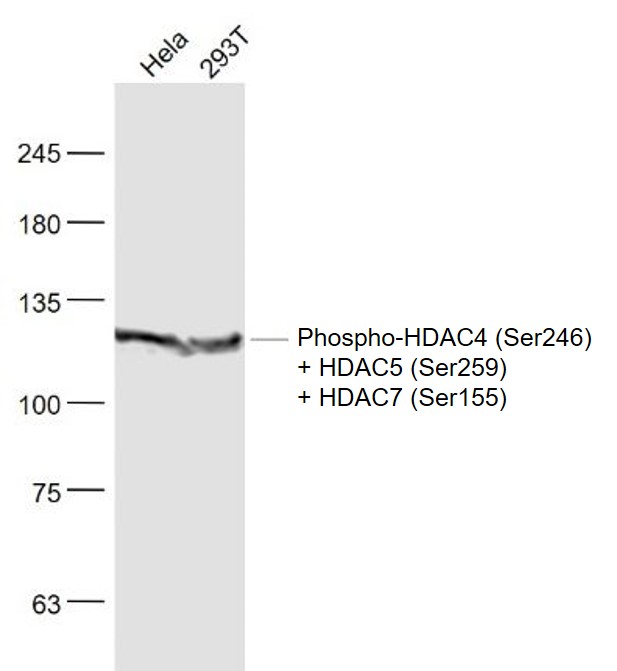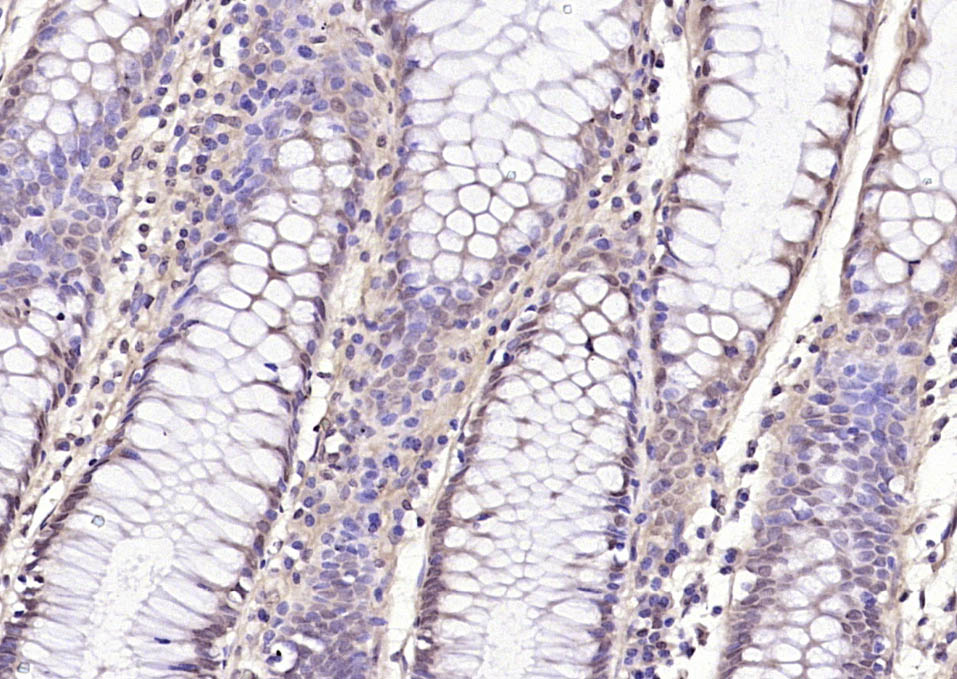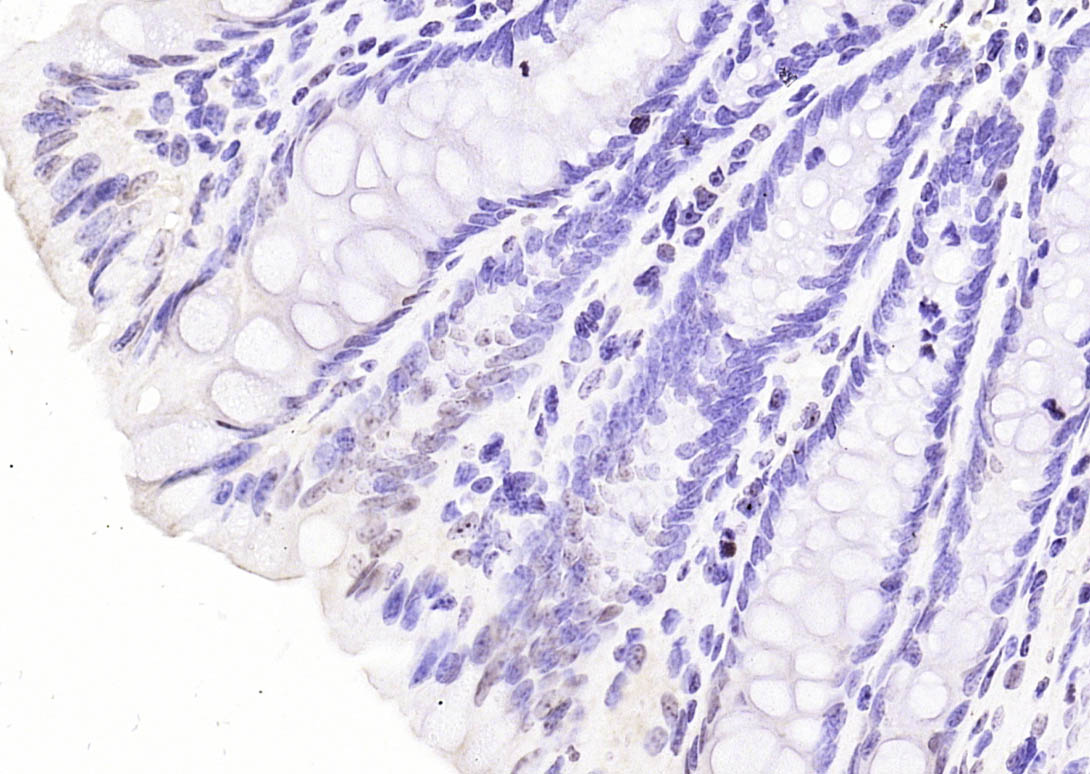
Rabbit Anti-Phospho-HDAC4 (Ser246) + HDAC5 (Ser259) + HDAC7 (Ser155)antibody
HDAC4(Phospho-Ser246); HDAC5(Phospho-Ser259); HDAC7(Phospho-Ser155); HD 4; HD4; HDAC 4; HDAC A; HDACA; Histone Deacetylase 4; Histone Deacetylase A; KIAA0288; EC 3.5.1.98; HA6116; p-HDAC4(Ser246); p-HDAC5(Ser259); p-HDAC7(Ser155).
View History [Clear]
Details
Product Name Phospho-HDAC4 (Ser246) + HDAC5 (Ser259) + HDAC7 (Ser155) Chinese Name 磷酸化组蛋白去乙酰化酶4/5/7抗体 Alias HDAC4(Phospho-Ser246); HDAC5(Phospho-Ser259); HDAC7(Phospho-Ser155); HD 4; HD4; HDAC 4; HDAC A; HDACA; Histone Deacetylase 4; Histone Deacetylase A; KIAA0288; EC 3.5.1.98; HA6116; p-HDAC4(Ser246); p-HDAC5(Ser259); p-HDAC7(Ser155). Product Type Phosphorylated anti Research Area Tumour Cell biology Neurobiology Signal transduction Apoptosis Immunogen Species Rabbit Clonality Polyclonal React Species Human, Mouse, (predicted: Rat, Chicken, Cow, Horse, Rabbit, ) Applications WB=1:500-2000 ELISA=1:5000-10000 IHC-P=1:100-500 IHC-F=1:100-500 IF=1:100-500 (Paraffin sections need antigen repair)
not yet tested in other applications.
optimal dilutions/concentrations should be determined by the end user.Theoretical molecular weight 119kDa Cellular localization The nucleus Form Liquid Concentration 1mg/ml immunogen KLH conjugated Synthesised phosphopeptide derived from human HDAC4 around the phosphorylation site of Ser246: TA(p-S)EP Lsotype IgG Purification affinity purified by Protein A Buffer Solution 0.01M TBS(pH7.4) with 1% BSA, 0.03% Proclin300 and 50% Glycerol. Storage Shipped at 4℃. Store at -20 °C for one year. Avoid repeated freeze/thaw cycles. Attention This product as supplied is intended for research use only, not for use in human, therapeutic or diagnostic applications. PubMed PubMed Product Detail Histones play a critical role in transcriptional regulation, cell cycle progression, and developmental events. Histone acetylation/deacetylation alters chromosome structure and affects transcription factor access to DNA. The protein encoded by this gene belongs to the class II histone deacetylase/acuc/apha family. It possesses histone deacetylase activity and represses transcription when tethered to a promoter. It coimmunoprecipitates only with HDAC3 family member and might form multicomplex proteins. It also interacts with myocyte enhancer factor-2 (MEF2) proteins, resulting in repression of MEF2-dependent genes. This gene is thought to be associated with colon cancer. Two transcript variants encoding different isoforms have been found for this gene. [provided by RefSeq].
Function:
Responsible for the deacetylation of lysine residues on the N-terminal part of the core histones (H2A, H2B, H3 and H4). Histone deacetylation gives a tag for epigenetic repression and plays an important role in transcriptional regulation, cell cycle progression and developmental events. Histone deacetylases act via the formation of large multiprotein complexes. Involved in muscle maturation via its interaction with the myocyte enhancer factors such as MEF2A, MEF2C and MEF2D.
Subunit:
Interacts with HDAC7. Homodimer. Homodimerization via its N-terminal domain. Interacts with MEF2C, AHRR, and NR2C1. Interacts with a 14-3-3 chaperone protein in a phosphorylation dependent manner. Interacts with BTBD14B. Interacts with KDM5B. Interacts with MYOCD. Interacts with MORC2. Interacts with ANKRA2.
Subcellular Location:
Nucleus. Cytoplasm. Shuttles between the nucleus and the cytoplasm. Upon muscle cells differentiation, it accumulates in the nuclei of myotubes, suggesting a positive role of nuclear HDAC4 in muscle differentiation. The export to cytoplasm depends on the interaction with a 14-3-3 chaperone protein and is due to its phosphorylation at Ser-246, Ser-467 and Ser-632 by CaMK4. The nuclear localization probably depends on sumoylation.
Tissue Specificity:
Ubiquitous.
Post-translational modifications:
Phosphorylated by CaMK4 at Ser-246, Ser-467 and Ser-632. Phosphorylation at other residues is required for the interaction with 14-3-3. Sumoylation on Lys-559 is promoted by the E3 SUMO-protein ligase RANBP2, and prevented by phosphorylation by CaMK4.
DISEASE:
Defects in HDAC4 are the cause of brachydactyly-mental retardation syndrome (BDMR) [MIM:600430]. A syndrome resembling the physical anomalies found in Albright hereditary osteodystrophy. Common features are mild facial dysmorphism, congenital heart defects, distinct brachydactyly type E, mental retardation, developmental delay, seizures, autism spectrum disorder, and stocky build. Soft tissue ossification is absent, and there are no abnormalities in parathyroid hormone or calcium metabolism.
Similarity:
Belongs to the histone deacetylase family. HD type 2 subfamily.
SWISS:
P56524
Gene ID:
9759
Database links:Entrez Gene: 9759 Human
Entrez Gene: 374207 Chicken
Entrez Gene: 208727 Mouse
Omim: 605314 Human
SwissProt: P83038 Chicken
SwissProt: P56524 Human
SwissProt: Q6NZM9 Mouse
Unigene: 20516 Human
Unigene: 318567 Mouse
Unigene: 23483 Rat
Product Picture
Hela(Human) Cell Lysate at 30 ug
293T(Human) Cell Lysate at 30 ug
Primary: Anti- Phospho-HDAC4 (Ser246) + HDAC5 (Ser259) + HDAC7 (Ser155)(SL3073R) at 1/1000 dilution
Secondary: IRDye800CW Goat Anti-Rabbit IgG at 1/20000 dilution
Predicted band size: 119 kD
Observed band size: 119 kD
Paraformaldehyde-fixed, paraffin embedded (Human colon cancer); Antigen retrieval by boiling in sodium citrate buffer (pH6.0) for 15min; Block endogenous peroxidase by 3% hydrogen peroxide for 20 minutes; Blocking buffer (normal goat serum) at 37°C for 30min; Antibody incubation with (Phospho-HDAC4 (Ser246) + HDAC5 (Ser259) + HDAC7 (Ser155)) Polyclonal Antibody, Unconjugated (SL3073R) at 1:200 overnight at 4°C, followed by operating according to SP Kit(Rabbit) (sp-0023) instructions and DAB staining.Paraformaldehyde-fixed, paraffin embedded (Mouse colon); Antigen retrieval by boiling in sodium citrate buffer (pH6.0) for 15min; Block endogenous peroxidase by 3% hydrogen peroxide for 20 minutes; Blocking buffer (normal goat serum) at 37°C for 30min; Antibody incubation with (Phospho-HDAC4 (Ser246) + HDAC5 (Ser259) + HDAC7 (Ser155)) Polyclonal Antibody, Unconjugated (SL3073R) at 1:200 overnight at 4°C, followed by operating according to SP Kit(Rabbit) (sp-0023) instructions and DAB staining.
Bought notes(bought amounts latest0)
No one bought this product
User Comment(Total0User Comment Num)
- No comment





 +86 571 56623320
+86 571 56623320
 +86 18668110335
+86 18668110335

